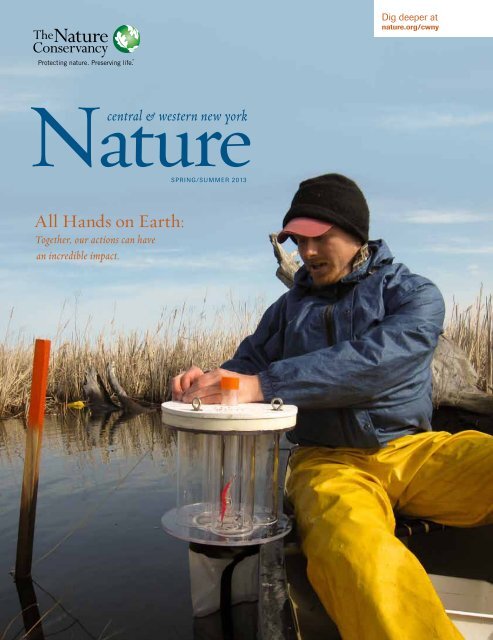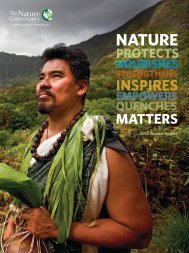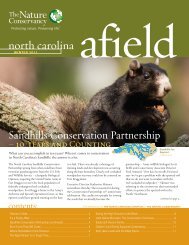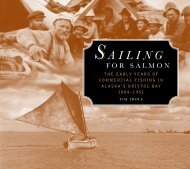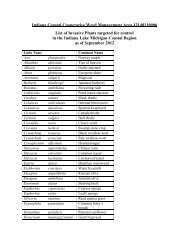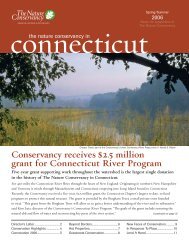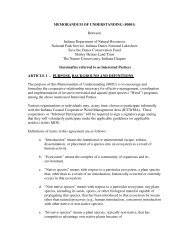CWNY Newsletter Spring 2013 - The Nature Conservancy
CWNY Newsletter Spring 2013 - The Nature Conservancy
CWNY Newsletter Spring 2013 - The Nature Conservancy
You also want an ePaper? Increase the reach of your titles
YUMPU automatically turns print PDFs into web optimized ePapers that Google loves.
Dig deeper at<br />
nature.org/cwny<br />
<strong>Nature</strong><br />
central & western new york<br />
SPRING/SUMMER <strong>2013</strong><br />
All Hands on Earth:<br />
Together, our actions can have<br />
an incredible impact.
nature works<br />
YOUR IMPACT<br />
Board Chair Clayton Millard and Chapter Director<br />
Jim Howe. © Jan Miller/TNC.<br />
It’s no secret that nature provides us with<br />
amazing goods and services. Wetlands<br />
filter our water and absorb storm surges.<br />
Forests remove CO2 and pump oxygen<br />
into the atmosphere. Every day, lands and<br />
waters provide us with food and fiber.<br />
<strong>Nature</strong> works hard for us. And as a society,<br />
we need to do better at acknowledging<br />
and sustaining the myriad services it<br />
generates—here in Central and Western<br />
New York and around the world. Still, just<br />
as we work to protect these life-essential<br />
benefits, we should also take time to<br />
celebrate the countless ways nature makes<br />
our lives richer and fuller.<br />
We hope this newsletter will help you do<br />
both. This issue features some of the<br />
results you’ve made possible. But you’ll<br />
also discover opportunities to get outside<br />
and connect with your family, your<br />
neighbors and your <strong>Nature</strong> <strong>Conservancy</strong>.<br />
What’s needed to protect and restore local<br />
natural resources? Greater awareness?<br />
More funding? Better laws? Yes, yes and<br />
yes. Whether you join us for a work day,<br />
visit a preserve, connect with us on<br />
Facebook or write a check to <strong>The</strong> <strong>Nature</strong><br />
<strong>Conservancy</strong>, your support and involvement<br />
are critical.<br />
We’re fond of saying that partnerships are<br />
fundamental to our success. You—our<br />
members—will always be our most<br />
important partners.<br />
Cover: Darran Crabtree, director of conservation<br />
programs, surveys for newly born northern pike in<br />
Lakeview Wildlife Management Area © Mat Levine/TNC.<br />
FRESH WATER<br />
With your help, we’re ensuring<br />
there is clean water, enough water<br />
and connected waters for all who<br />
depend on them.<br />
1,500<br />
pounds of water chestnut removed from<br />
Eastern Lake Ontario streams and bays.<br />
LAND You’ve helped us protect nearly 100,000<br />
acres in Central and Western New York, including a<br />
27,000-acre network of preserves. We care for these<br />
lands through science-based stewardship while adding<br />
strategic new parcels.<br />
19,778<br />
$30 MILLION<br />
trees protected Last year in a 107-acre oak-hickory forest<br />
near Canandaigua Lake through a purchase made possible by a<br />
grant from TD Bank.<br />
in public funding secured<br />
for invasive species prevention,<br />
early detection and strategic<br />
management in the Finger Lakes<br />
and throughout New York.<br />
52,000<br />
birds observed by volunteers as<br />
part of our Lake Ontario Migratory<br />
Bird Stopover Project.<br />
10,000<br />
one-year-old cisco, an essential prey species for salmon and lake trout,<br />
were released into Irondequoit Bay by NYS Department of Environmental<br />
Conservation and U.S. Geological Survey as a result of our research.<br />
COASTS With your help, we’re restoring coastal<br />
habitats and assisting people and nature in adapting to<br />
the impacts of climate change.<br />
64,000<br />
acres of coastal wetlands in Lake Ontario and the upper St.<br />
Lawrence River function as the lungs of the lake and help protect<br />
shoreline communities. We’re restoring the natural characteristics<br />
that keep these wetlands healthy.<br />
2 DOLLARS in economic benefits<br />
to the economy of the Great Lakes region are generated from<br />
each dollar invested in coastal restoration.<br />
8 communities<br />
in Northern New York will benefit from a new payment in lieu of<br />
taxes program in our 15,000-acre Tug Hill Conservation Area.<br />
INTERNATIONAL<br />
Thanks to you, we share our expertise and resources with the world to help<br />
combat environmental problems globally.<br />
1st <strong>Nature</strong> <strong>Conservancy</strong> project director for Lake Tanganyika<br />
in Tanzania hired thanks to Central and Western New York supporters.<br />
1 2 3 4<br />
5 6<br />
7 8<br />
40%<br />
more young northern pike in the lower<br />
St. Lawrence River if more natural levels and<br />
flows are restored in Lake Ontario.<br />
$1 MILLION<br />
secured through a North American Wetlands Conservation Act grant<br />
to acquire 480 acres along Sodus Bay.<br />
2 spring <strong>2013</strong><br />
<strong>The</strong> <strong>Nature</strong> <strong>Conservancy</strong> in Central and Western New York | nature.org/cwny 3
ON THE WEB »<br />
Discover more<br />
lands you’ve helped protect at<br />
nature.org/cwnypreserves<br />
4 spring <strong>2013</strong><br />
<strong>The</strong> <strong>Nature</strong> <strong>Conservancy</strong> in Central and Western New York | nature.org/cwny 5
YOUR waters<br />
What’s Our Fresh Water Future?<br />
We know the ingredients of healthy lakes and rivers: abundant and diverse native fish, clean and naturally flowing waters and a healthy<br />
fringe of coastal marshes and dunes providing shoreline protection. But in many cases our rivers and lakes have been heavily altered.<br />
We can’t go back to wilderness past, but with your help we can rethink some outdated decisions for a better future—and use science to<br />
work with nature rather than against it.<br />
We’re using data collected on invasive species to<br />
develop computer models that predict the spread<br />
of aquatic invasives and help determine the best<br />
management approach. © Greg Chapman.<br />
After we restored natural features favored by fish,<br />
like meandering channels and potholes, at Lakeview<br />
Wildlife Management Area in Jefferson Co., young-ofthe-year<br />
northern pike as well as largemouth bass,<br />
yellow perch and bowfin were found emigrating<br />
from the new channels. © Mat Levine/TNC.<br />
<strong>The</strong> entire Mad River Swamp region is protected<br />
by our 15,000-acre Tug Hill Conservation Area.<br />
© Mat Levine/TNC, Aerial Support by Lighthawk.<br />
Above: El Dorado Preserve on Lake Ontario during high water © Mat Levine/TNC.<br />
Securing New York’s ‘North Coast’<br />
By stuart gruskin<br />
At the direction of Gov. Andrew Cuomo, the New York<br />
State 2100 Commission has responded swiftly to the<br />
severe damage caused by Hurricane Sandy with concrete<br />
recommendations for lessening the impact of future storms<br />
on New York’s coastal communities. A proposed plan for<br />
regulating the levels of Lake Ontario offers the opportunity<br />
to apply these recommendations to our own coastline.<br />
With storms like Sandy expected to increase in frequency<br />
as our climate changes, the report outlines a common sense<br />
path toward resilient coastlines through a combination of<br />
engineered and “living shoreline” techniques, with nature as<br />
a partner rather than an adversary.<br />
ON THE WEB »<br />
Read more about Plan Bv7, watch video testimonials and<br />
learn how you can get involved at nature.org/bv7.<br />
In implementing the Commission’s recommendations on New<br />
York’s “north coast”—the 700-mile Great Lakes shoreline—<br />
we must recognize the critical role of natural variation in<br />
water levels in shaping and maintaining our shores.<br />
Similar to ocean tides on the ocean shore, the natural ebb<br />
and flow of water levels in a Great Lake builds beaches and<br />
maintains healthy, diverse wetlands. Since 1960, water levels<br />
in Lake Ontario have been regulated by a dam in the St.<br />
Lawrence River. This regulation has stifled the ebb and flow<br />
of water levels, and degraded the wetlands and natural<br />
protections of a living shoreline.<br />
A new proposed regulation plan—Plan Bv7—will partially<br />
restore the long-term cycles in Lake Ontario’s water levels<br />
while continuing to dampen the extreme levels that may cause<br />
economic damage. This new plan is the essential ingredient in<br />
the “green infrastructure” of a resilient Lake Ontario coast.<br />
Stuart Gruskin is chief conservation and external affairs<br />
officer for <strong>The</strong> <strong>Nature</strong> <strong>Conservancy</strong> in New York<br />
Purple trillium . © Mat Levine/TNC.<br />
LEAF interns perform essential stewardship work in Central<br />
and Western New York waters each summer while gaining<br />
exposure to environmental careers. © MAT LEVINE/TNC.<br />
TNC’s Scott Kruger and DEC’s Dave Gordon check nets<br />
for spawning cisco (lake herring) in Chaumont Bay. <strong>The</strong><br />
<strong>Conservancy</strong> is partnering with Cornell University<br />
to figure out how to bolster the Eastern Lake Ontario<br />
cisco population. © Mat Levine/TNC.<br />
6 spring <strong>2013</strong><br />
<strong>The</strong> <strong>Nature</strong> <strong>Conservancy</strong> in Central and Western New York | nature.org/cwny 7
your actions<br />
<strong>Conservancy</strong> Member Invites You to ‘Fold the Flock’<br />
Five North American birds have become extinct in modern<br />
times: the great auk, the Carolina parakeet, the heath hen,<br />
the Labrador duck and the passenger pigeon.<br />
<strong>Nature</strong> <strong>Conservancy</strong> member Andy Stern recently<br />
accompanied his brother-in-law, artist Todd McGrain,<br />
on a quest to memorialize these lost species. Stern and<br />
McGrain spent two years seeking out the locations where<br />
the birds were last seen in the wild to give them a presence<br />
in the places they once lived.<br />
Now, Stern is on a mission to involve others in the memorial,<br />
visiting schools and other groups in Rochester and around<br />
the country to symbolically recreate a flock of passenger<br />
pigeons using an origami pattern.<br />
<strong>Nature</strong>.org: How did this all begin—the sculptures, the<br />
journey to find these places and making this film?<br />
Stern: Todd always had a fascination with birds. His father<br />
was a birder, and as a sculptor I think Todd was always<br />
intrigued by the shapes of birds. He spent a decade creating<br />
these large bronze sculptures of the lost birds. When we set<br />
off to try and place them where the birds were last seen, we<br />
didn’t have a plan. We were just following the birds and<br />
discovering their stories as we went.<br />
<strong>Nature</strong>.org: Now you’re working on a project to build a<br />
flock of one million origami pigeons? What made you<br />
choose this unusual activity?<br />
Stern: 2014 is the 100-year anniversary of the passenger<br />
pigeon’s extinction. Our mission with <strong>The</strong> Lost Bird Project<br />
is to help people connect more deeply to the world though<br />
art. Origami fits with this goal because it’s physical; you’re<br />
focused and connecting with the activity. It’s a way of<br />
connecting to the loss, too.<br />
“Our mission with <strong>The</strong><br />
Lost Bird Project is to help<br />
people connect more deeply<br />
to the world though art.”<br />
—Andy Stern<br />
<strong>Nature</strong>.org: How does <strong>The</strong> <strong>Nature</strong> <strong>Conservancy</strong>’s work<br />
connect to this project?<br />
Stern: <strong>The</strong> <strong>Nature</strong> <strong>Conservancy</strong> is working here in New<br />
York and around the world to figure out more about where<br />
birds go and the habitats they need for survival (see sidebar).<br />
But your work goes beyond birds. <strong>The</strong> <strong>Conservancy</strong> is also<br />
helping to prevent losses of fish and many other species, and<br />
you are helping connect people to nature. That’s my goal, too.<br />
<strong>Nature</strong>.org: What is your ultimate hope for the project?<br />
My dream is to get schools and other groups across the<br />
country engaged in Fold the Flock. My hope is that by<br />
connecting people with these birds’ stories we’ll collectively<br />
gain a new perspective about fragility. It was once unbelievable<br />
this species would vanish because they were estimated<br />
to number in the billions. <strong>The</strong>re’s still much we don’t know<br />
about the consequences of losses like this. But we know the<br />
world is less without them.<br />
ON THE WEB »<br />
For a schedule of screenings of <strong>The</strong> Lost Bird Project, visit<br />
lostbirdfilm.org.<br />
You Can Help Migratory<br />
Birds in Central<br />
and Western New York<br />
People depend on the great migrations of birds. Migratory<br />
birds play an important role in seed dispersal and<br />
pollination, and they aid agriculture by eating insect pests.<br />
<strong>The</strong>y also inspire and amaze us, connecting us to the<br />
natural world in our backyards and much further away.<br />
But migration is extremely difficult. For some species, 85<br />
percent of adult bird mortality occurs during migration.<br />
With the help of 50 skilled volunteer birders, <strong>The</strong> <strong>Nature</strong><br />
<strong>Conservancy</strong> conducted a three-year study to discover<br />
exactly where migratory birds in the Lake Ontario<br />
watershed go. Now, we are disseminating our findings<br />
to help protect a network of “stopover” locations along<br />
their migratory pathways.<br />
With $20,000 in funding for our migratory bird<br />
project, <strong>The</strong> <strong>Nature</strong> <strong>Conservancy</strong> can:<br />
• Share the results and an accompanying user guide<br />
with natural resource managers and landowners<br />
• Work with agencies to get the results incorporated<br />
into shoreline management and permitting,<br />
energy siting, land management decisions and<br />
open space planning<br />
• Conduct outreach to individual, corporate and<br />
municipal landowners to enlist their help in<br />
protecting and managing important stopover sites.<br />
Above: Areas in yellow, orange and red are predicted to have high abundance<br />
and diversity of migratory birds during spring and fall migrations.<br />
Fold the Flock at the Harley<br />
School in Rochester.<br />
Download an origami pattern<br />
at foldtheflock.org.<br />
© Fran Laks/Lost Bird Project.<br />
get involved<br />
See the study results at nature.org/nybirds.<br />
To support this project, contact Jan Miller at<br />
jan_miller@tnc.org or (585) 546-8030 x 28.<br />
8 spring <strong>2013</strong><br />
<strong>The</strong> <strong>Nature</strong> <strong>Conservancy</strong> in Central and Western New York | nature.org/cwny 9
Your community<br />
Take Action<br />
for <strong>Nature</strong><br />
<strong>The</strong> <strong>Nature</strong> <strong>Conservancy</strong> in Central<br />
and Western New York invites you<br />
to deepen your engagement with<br />
conservation this summer. Take our<br />
suggestions of ways to get involved<br />
or just get inspired to create your<br />
own nature-centric activities. Get<br />
started at nature.org/cwny!<br />
• JOIN A WORK DAY<br />
This summer, we’ll continue to cultivate the next<br />
generation of environmental leaders through our<br />
LEAF program, hosting three students as they<br />
support science and stewardship. We need your<br />
help in the field too (see next page)!<br />
Board of Trustees<br />
Clayton Millard<br />
Rochester, Chair<br />
Lew Allyn<br />
Naples, Florida<br />
Brian Baird<br />
Buffalo<br />
Bruce Bongarten, Ph.D.<br />
Syracuse<br />
John Fitzpatrick, Ph.D.<br />
Ithaca<br />
Bruce Gilman Ph.D.<br />
Canandaigua<br />
Richard Hill,<br />
Emeritus, Remsen<br />
Sarah Hurlbut<br />
Rochester<br />
Bill Jacques<br />
Rochester<br />
D. Bruce Johnstone, Ph.D.<br />
Buffalo<br />
Victoria Kennedy<br />
Fayetteville<br />
Deb Koen<br />
Rochester<br />
Tony Lee<br />
Rochester<br />
Tom Lunt<br />
Orchard Park<br />
Brian O’Shea<br />
Barneveld<br />
John Palmer, Ph.D.<br />
Fayetteville<br />
Robert Papworth<br />
Syracuse<br />
Stephen Rosenfeld, M.D.<br />
Pittsford<br />
Chuck Ruffing, Ph.D.<br />
Rochester<br />
Sue van der Stricht<br />
Rochester<br />
Susan Suwinski<br />
Ithaca<br />
Jim Wagner<br />
Syracuse<br />
• SHARE YOUR PHOTOS<br />
We depend on striking images to communicate<br />
how conservation benefits people and nature<br />
in Central and Western New York. Please<br />
consider sharing your photos with us and<br />
help tell our story!<br />
© Mat Levine/TNC<br />
• SUPPORT OUR WORK<br />
Donating is quick, easy and effective. If every<br />
member returned $25 in the enclosed envelope,<br />
we could raise more than $350,000 for nature!<br />
Staff List<br />
Rochester Office<br />
Jim Howe, Executive Director<br />
Stevie Adams, Freshwater Conservation Practitioner<br />
Kristin France, Senior Conservation Scientist<br />
Kate Frazer, Communications Manager<br />
Gretchen Holtz, Office Manager<br />
David Klein, Senior Field Rep for Lake Ontario<br />
Liz Marr, Finance/Operations Manager<br />
Jan Miller, Senior Philanthropy Officer<br />
Zachary Odell, Director of Land Protection<br />
Gregg Sargis, Director of Ecological Management<br />
Stacy Wais Seretto, Philanthropy Manager<br />
Raymond Waweru, Research & Communications Asst.<br />
Northern New York Project Office<br />
Mat Levine, Field Representative<br />
Mary Ripka, Office Manager<br />
Lorna Wright, Tug Hill Project Director<br />
Rob Williams, St. Lawrence-Eastern Lake Ontario Partnership<br />
for Regional Invasive Species Management Coordinator<br />
French Creek Project Office<br />
Darran Crabtree, Chapter Director of Conservation<br />
Niagara Frontier Project OfFICE<br />
Patrick McGlew, Project Director<br />
© Nick Hall<br />
• LIKE US ON FACEBOOK<br />
Join <strong>The</strong> <strong>Nature</strong> <strong>Conservancy</strong>’s New York facebook<br />
fan page for photos, events, breaking news and<br />
discussions on everything nature in New York.<br />
© Mat Levine/TNC<br />
Work Days<br />
June 1, 9:00 am<br />
Cattaraugus County<br />
Deer Lick: <strong>Spring</strong> cleanup and trail<br />
work. (Rain date: Saturday, June 15)<br />
June 12, 9:00 am • Oneida County<br />
Rome Sand Plains: Lupine planting<br />
to help restore populations of wild<br />
blue lupine.<br />
September 21, 9:00 am<br />
Monroe County<br />
Thousand Acre Swamp: Autumn<br />
cleanup and winter preparation.<br />
September 12, 9:00 am<br />
Oneida County<br />
Rome Sand Plains:<br />
Trash cleanup.<br />
September 14, 9:00 am<br />
Jefferson County<br />
El Dorado Preserve and Bird<br />
Sanctuary: Sandy beach cleanup.<br />
To register for work days, contact<br />
Mary Ripka at mripka@tnc.org or<br />
(315) 387-3600 See a full list of hikes and<br />
other events at nature.org/nyevents<br />
Printed on 90% recycled (including<br />
30% PCW), process chlorine-free<br />
paper, creating the following benefits<br />
24.4 trees preserved<br />
for the future<br />
1148.5 lbs<br />
solid waste not<br />
generated<br />
70.6 lbs<br />
water-borne waste<br />
not created<br />
2,261 lbs net<br />
greenhouse<br />
gases prevented<br />
10 spring <strong>2013</strong><br />
<strong>The</strong> <strong>Nature</strong> <strong>Conservancy</strong> in Central and Western New York | nature.org/cwny 11
Your<br />
<strong>The</strong> <strong>Nature</strong> <strong>Conservancy</strong><br />
1048 University Avenue<br />
Rochester, NY 14607<br />
(585) 546-8030<br />
nature.org/cwny<br />
central & western new york<br />
NON PROFIT ORG<br />
U.S. Postage<br />
PAID<br />
Eureka, MO<br />
Permit #101<br />
is enclosed<br />
nature.org/cwny<br />
facebook.com/ny.natureconservancy<br />
© <strong>2013</strong> TNC-<strong>CWNY</strong><br />
in this issue »<br />
Celebrating Your Impact for <strong>Nature</strong> and People<br />
Clockwise from left: El Dorado Preserve © Mat Levine/TNC, Conservation Practitioner Stevie Adams monitoring wetland restoration © Mat Levine/TNC, Fold the Flock © Fran LAKS.


